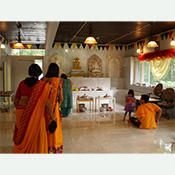 Jain temples serve as vibrant centers for the interaction of monastics and laypeople. Here Jains pray, meditate, listen to sermons, sing religious songs, and perform rituals before images of the tirthankaras.
Jain temples serve as vibrant centers for the interaction of monastics and laypeople. Here Jains pray, meditate, listen to sermons, sing religious songs, and perform rituals before images of the tirthankaras.
View full album
The Jain tradition is not only the path of asceticism trod by the monks and nuns, but is one that emphasizes the life and well-being of the laity. Jains build temples and install images of the tirthankaras. They come to the temples, vibrant centers of religious and social activity, for meditation, worship, and festivals. When Jains can afford to do so, they construct their temples of marble to create a cool, calm oasis from the burning Indian sun and worldly bustle. The great pilgrimage temples, such as Palitana in Gujarat and Mount Abu in Rajasthan, are often situated on hilltops.
Jains go to the temple to pray, meditate, perform rituals, join in religious songs, and listen to monks. In the Jain temple, a bell is always ringing, a song is always being sung, and a pure, reflective atmosphere pervades. Jain children attend pathshala, or religious classes, at a monastery or nunnery. Increasingly, major Jain temples aiming to create just such an atmosphere are being built in the U.S.
The Jain tradition does not speak with a unanimous voice on the matter of these stone and metal images of the tirthankaras. Murtipuja means, literally, the “worship of images.” While two Shvetambara sectarian groups, the Sthanakvasis and Terapanths, reject image-worship, both Digambara and Shvetambara Murtipujak traditions include the honoring of the tirthankaras with rites of puja. Jains agree, however, that the tirthankaras do not in any way “receive” the offerings made by worshipers. There is no notion of gifts offered being “returned” later on, as in Hindu worship. Indeed, in the view of Murtipujak Jains, acts of worship are among the ways in which those who perform them purify themselves. Through praising and honoring the Jina, one is better enabled to emulate the qualities embodied in the Jina and to turn the mind toward liberation.
As with the Murtipujak view of self purification through worship, giving gifts of flowers, water, and food to the images of the jinas or tirthankaras is felt to be beneficial to the giver. It is parallel to the devotional delight Jains feel in offering food to a sadhu or sadhvi. The mendicants at one’s door represent the same ideal in living form that the images of the tirthankaras symbolize in stone or metal—the ideal of the karma-liberated, undefiled soul. The laity earn merit by supplying the sadhus and sadhvis with food and necessities, just as they do by contributing to the maintenance of the temple or the performance of puja.